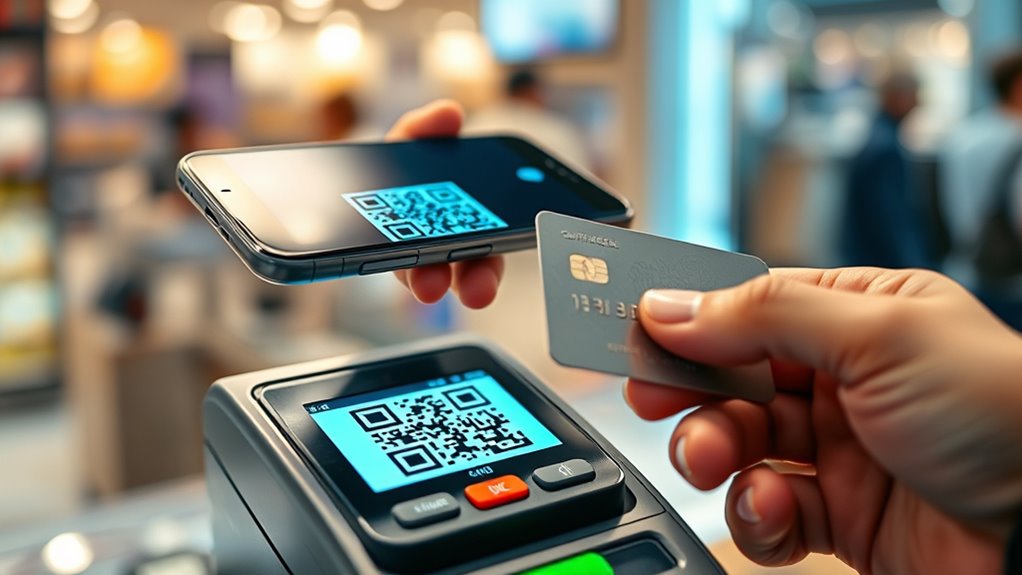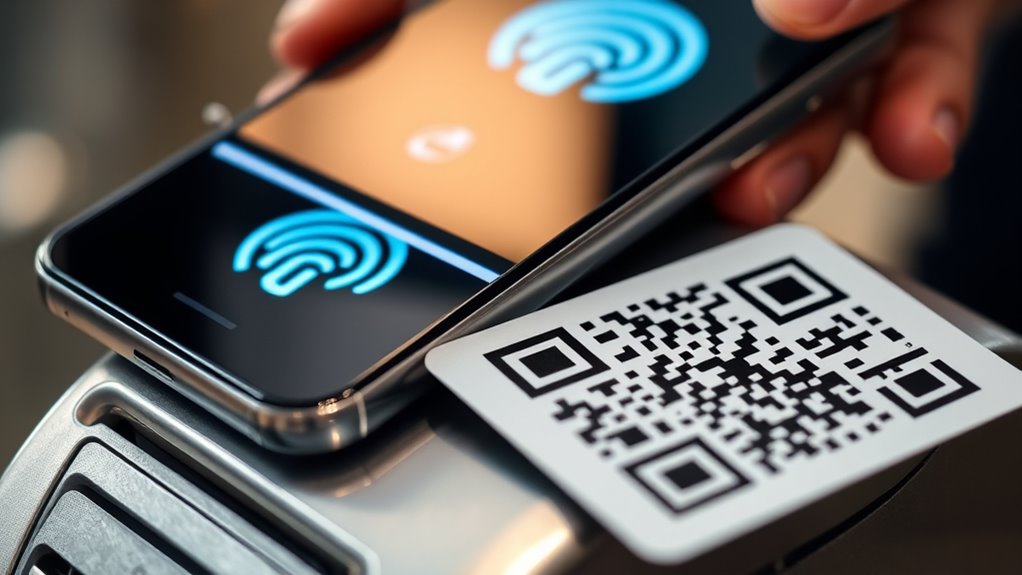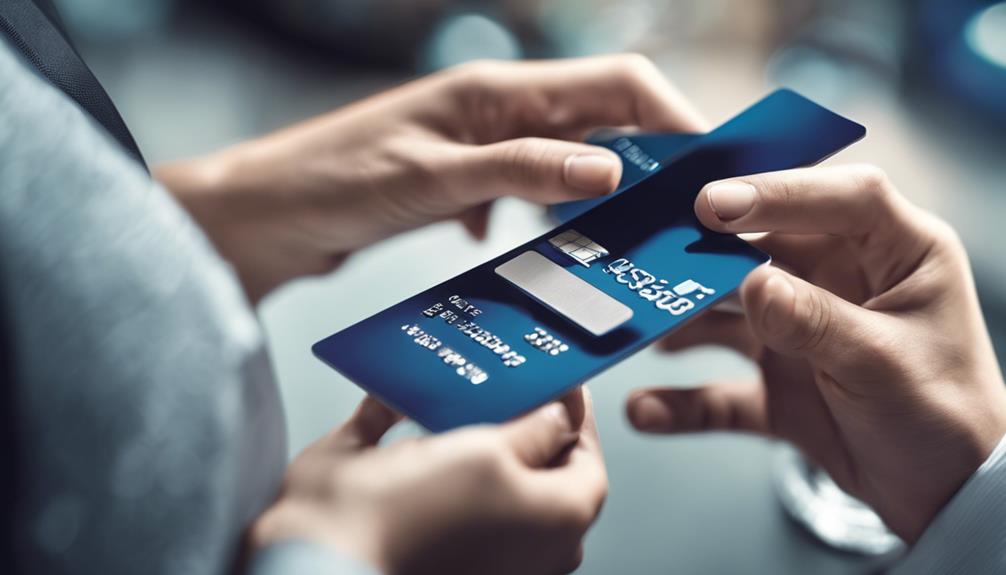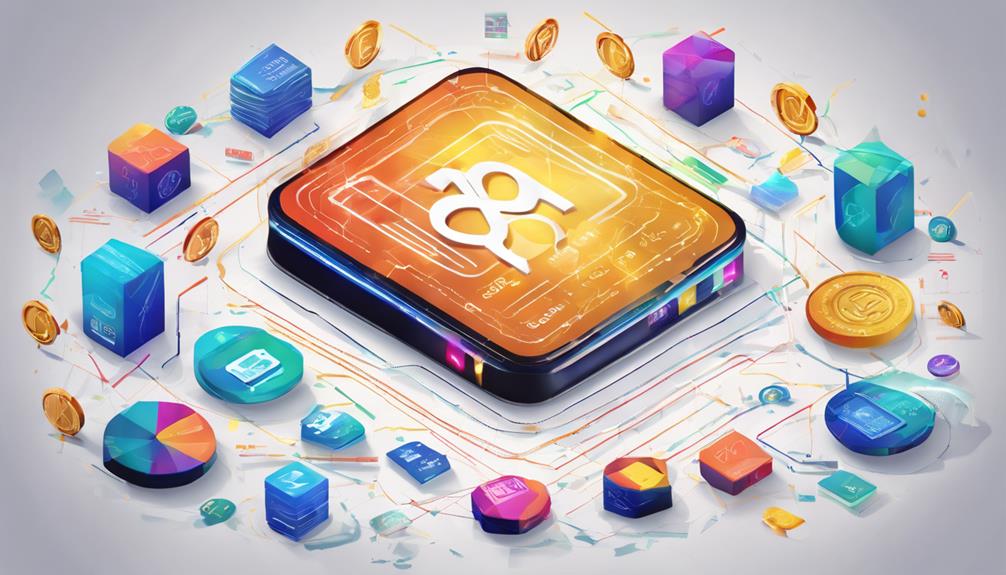Contactless tech includes methods like NFC, QR codes, and wearables that let you pay quickly and contact-free. NFC uses wireless signals between your device and a payment terminal, while QR codes are scanned for instant transactions without hardware needed. Wearables like smartwatches also support contactless payments. These options make shopping faster and more secure, and they’re evolving to fit your lifestyle. Keep exploring to discover how these innovations are shaping your future transactions.
Key Takeaways
- NFC (Near Field Communication) enables quick, tap-to-pay transactions by establishing a secure wireless connection between devices within a few centimeters.
- QR codes are scannable images that facilitate contactless payments and data sharing without specialized hardware.
- Wearable devices like smartwatches support contactless payments using NFC technology for convenient transactions.
- Biometric authentication (fingerprint, facial recognition) enhances security in contactless payment methods.
- The industry is expanding with technologies like NFC, QR codes, and biometrics to improve speed, security, and user convenience.

Have you noticed how contactless technology is transforming the way we pay? More people than ever are choosing quick, secure, and hygienic methods to complete transactions, thanks to innovations like NFC, QR codes, and digital wallets. The market is booming, with the global contactless payment industry reaching nearly $58 billion in 2024 and expected to grow to over $70 billion in 2025. By 2029, projections estimate it will surpass $150 billion, driven by infrastructure expansion and changing consumer preferences. This rapid growth isn’t just a trend; it’s a fundamental shift in how we handle everyday transactions.
Contactless payments are revolutionizing transactions, with industry expected to surpass $150 billion by 2029.
You’ll find that a significant majority of consumers, around 82% globally, now use contactless payments regularly. In the United States alone, 65% of card transactions are contactless-enabled, showing how deeply integrated these methods have become. Mobile wallets, accessed mainly through smartphones (68%) and smartwatches (41%), are particularly popular, especially among younger and tech-savvy users. Fascinatingly, women are 22% more likely than men to prefer contactless payment methods, and over 70% of consumers favor digital wallets as their primary shopping payment option. This widespread adoption fuels continuous growth, encouraging merchants to implement contactless systems to meet customer expectations.
Transaction volumes reflect this shift. In 2023, contactless transactions worldwide exceeded $17 trillion—a 25% increase from the previous year. Nearly half of all card transactions globally are processed via contactless methods, a significant jump from only 30% in 2020. In the United States, mobile wallet transactions alone grew 32% year-over-year, reaching $1.9 trillion. These payments are incredibly fast, taking just 1 to 2 seconds—about 60% quicker than chip card payments—making checkout smoother and more efficient. Visa processed 35 billion contactless transactions in 2023, demonstrating consumer trust and widespread acceptance. The integration of contactless payments with various sectors, including transit systems and retail environments, further accelerates adoption. Additionally, the ongoing development of secure payment infrastructure is crucial for maintaining consumer confidence as these technologies become more prevalent.
Different technologies power these contactless methods. NFC, or Near Field Communication, is the most common for tap-to-pay, allowing quick, secure exchanges between devices and terminals. QR codes are also popular, especially since they don’t require specialized hardware, making them ideal for retail, transportation, and other sectors. Wearables like smartwatches now support contactless payments, offering a convenient alternative to carrying cards or phones. Biometric authentication—using fingerprint or facial recognition—is increasingly integrated to enhance security while maintaining frictionless experiences.
The impact on behavior is clear. Nearly half of Americans report spending more with digital wallets than traditional methods, and over half would stop shopping at merchants that don’t accept contactless payments. Small businesses embracing these methods see increased sales and happier customers, thanks to faster checkout speeds and improved hygiene. Governments worldwide are supporting these changes through initiatives promoting cashless economies, further encouraging adoption. As contactless technology continues to evolve, it’s clear that it’s shaping the future of how we pay, making transactions faster, safer, and more convenient.
Frequently Asked Questions
How Secure Is Contactless Payment Technology Against Hacking?
You’re wondering how secure contactless payments are against hacking. While NFC technology uses strong security features like encryption, tokenization, and proximity requirements to protect your data, hackers are finding new ways to exploit vulnerabilities. Despite these layers, the increasing attack rates mean you should stay vigilant. Using updated security tools and being aware of potential risks helps you keep your contactless transactions safer.
Can Contactless Tech Work Without an Internet Connection?
Yes, contactless tech can work without the internet. You use secure local storage of payment credentials or tokens in your device, allowing transactions to process offline. NFC and QR code systems enable quick payments or data exchanges without online access. Once the internet reconnects, your device syncs transactions. This offline capability is especially useful in areas with poor connectivity, ensuring your payments remain seamless and secure even without an active internet connection.
What Are the Environmental Impacts of QR Code Usage?
You might wonder about the environmental impacts of QR codes. When you use QR codes, you’re helping reduce paper waste by avoiding printed bills and receipts, which cuts down on deforestation, water, and energy use. This also decreases transportation emissions and promotes recycling. By choosing QR codes, you support sustainability efforts, conserve resources, and encourage eco-friendly habits, ultimately contributing to a healthier planet and more conscious consumer behavior.
How Does NFC Compare to Bluetooth in Data Transfer?
Think of NFC and Bluetooth like a quick handshake versus a long conversation. NFC transfers data slowly, perfect for small, secure exchanges like payments or pairing devices. Bluetooth, on the other hand, moves data faster, suitable for streaming or sharing large files. You’ll find NFC offers limited capacity but high security, while Bluetooth handles bigger data loads but requires careful security settings.
Are There Privacy Concerns With Contactless Data Sharing?
You might wonder if contactless data sharing raises privacy concerns. It does, because large amounts of personal info are collected and stored, which can be vulnerable to cyberattacks or malware. Fraudsters use techniques like phishing or skimming to steal data, and weak security protocols increase risks. While many trust these systems, you should stay cautious, use strong authentication, and follow best practices to protect your privacy.
Conclusion
As you explore the world of contactless tech, you’ll discover it’s like having a friendly handshake without the fuss—convenient, seamless, and quietly reliable. These innovations gently simplify your everyday transactions, making life feel a little smoother. Embrace the subtle magic behind NFC, QR codes, and more, knowing they’re quietly working in the background to enhance your experience. In this modern dance of technology, you’re always a step ahead, effortlessly connected and effortlessly cared for.









